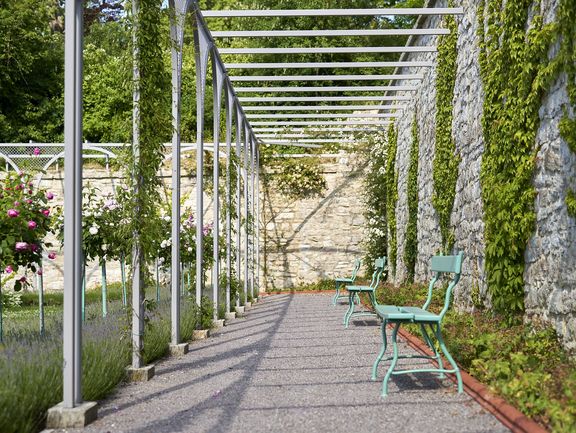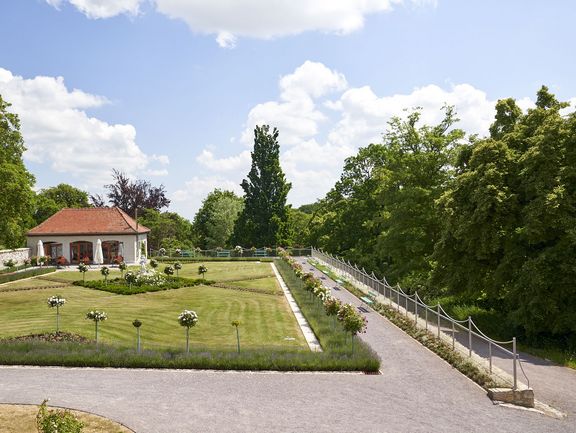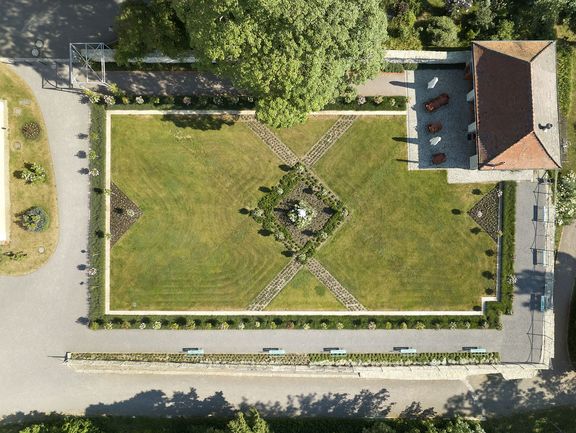In preparation of the Federal German Garden Show (BUGA) in 2021, the Klassik Stiftung Weimar completed significant renovation measures in the Ettersburg Castle Park, a UNESCO World Heritage Site. The purpose of these measures was to restore and safeguard the historic walls and parterre surfaces at Ettersburg Castle in accordance with landmark preservation guidelines.
The supporting walls along the west and east parterre required particular attention with respect to safeguarding their historical significance and structural integrity. A thorough analysis of the existing structural substance and the various forms of damage it had suffered was essential before renovation work could begin in summer 2020. The techniques and methods applied in the restoration efforts included both traditional approaches and modern procedures. This included removing vegetation, restoring the drainage outlets, structurally stabilising cracks and partially replacing stones. To prevent further cracking, special techniques were used, e.g. needling, cavity grouting and tension rods with fabric coverings. Ring beams and reinforced concrete slabs were occasionally integrated into the coping to strengthen the structural integrity of the walls.
During construction, workers discovered further damage at the foundation level and in the masonry. This required additional measures; sections that were damaged or at risk of collapsing were reconstructed in such a way that preserved their deformation. Stones were partially replaced in areas where the walls bulged outwards or were missing. Existing building materials were used as often as possible. If these were not available, pieces of limestone resembling the historic building material were anchored into the structure using binding stones and, in some cases, threaded stainless-steel rods.
The parterre surfaces on both sides of the New Castle were extensively refurbished. The goal was to preserve the historic substance of these surfaces as best as possible while improving accessibility and functionality for the visitors. The historic 19th-century pergolas were partially reconstructed (west parterre), whereby later changes made in the 20th century were maintained (east parterre). The cast-iron frames of the historic benches were recast, and replicas of the original clay curb stones, some of which still existed, were recreated in a brick factory in Saxony. Steel stairs and guardrails were also added to improve accessibility and pedestrian safety.
Unobtrusive pillar lights were installed between the visitor parking lot and the Rifle Hall, and lighting was integrated into the railing of the steel staircase to optimise path illumination. From now on, park visitors and guests of the restaurant and castle hotel can walk through this historic park safely in the evening hours.
With the completion of the measures, which coincided with the official opening of the BUGA external venue on 20 May 2021, the park grounds have been modernised for the coming years and the touristic infrastructure has been significantly improved. More importantly, the historic authenticity of the park grounds has been preserved as a Gesamtkunstwerk.
Schedule
Start of planning phase: September/October 2019
Start of construction: July/October 2020
Completion: May 2021
Financing and funding
This project was financed 25 % with revenues provided by the Free State of Thuringia and 75 % with ERDF funding.
Planning partners
Structural planning and engineering: Architektur- und Ingenieurbüro Dipl.-Ing. J. Kowalski, Halle
Outdoor installations: Landschaftsarchitekten Haufe Lohse Pätzig, Dresden
Technical equipment/high-voltage systems: Ingenieurbüro Tobias Böhm, Weimar


![[Translate to English:] Zur Website des Europäischen Fonds für regionale Entwicklung logo: European Regional Development Fund](/assets/Dokumente/KOEM/Logos/EFRE/Logo_EFRE_dt.jpg)













